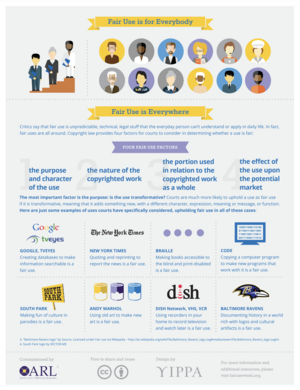February 20-24 marks the annual celebration of the important doctrine of fair use. Fair use impacts our day-to-day activities, often without being noticed. We encounter fair use materials by watching a YouTube game review, reading content in school, watching parody television, and even writing essays. Fair use creates an exception to copyright, allowing copyrighted materials to be reused without the creator’s permission under certain guidelines. This flexibility helps copyright law adapt to our ever-changing culture. Fair use works within copyright law to protect authors’ rights while allowing for the use of creative content to engage with diverse audiences.
How can we use copyrighted materials in education, to produce satire and memes without infringing on author rights? This is where fair use enters the playing field. Fair use helps preserve First Amendment rights of free speech. It promotes conversation for purposes such as criticism, comment, news reporting, teaching (including multiple copies for classroom use), scholarship or research. All four of the following factors are considered when evaluating whether the use of a material is fair:

- The purpose and character of the use: Are you using the work for not-for-profit educational uses or for profit? Is value added to the original by creating new information? Examples of this would be incorporating quotations from your textbook to support the thesis of an essay for a course or including clips of videos in a commentary or criticism of the original work- these do not generate a profit, and you are transforming the work by adding something new with a different message.
-
The nature of the copyrighted work: How are you using the work in relation to the author’s original purposes? Is it published material? “This factor analyzes the degree to which the work that was used relates to copyright’s purpose of encouraging creative expression” (Fair Use Index). Nonfiction is often given more leeway for fair use because sharing facts and information often benefits the public. An example of this would be using clips from a documentary about a historical figure in your classroom.
-
The portion used in relation to the copyrighted work as a whole: How much of the work are you using? In many college courses, instructors scan in one chapter of a textbook for their students to read during a unit. This might be considered fair use, whereas scanning the entire textbook and providing it to students without consulting the publisher might not. The context used is also looked at. For example, it may be fair use to quote from a magazine article in your personal blog, but not if you are quoting the “heart” or “scoop” of the story.
-
The effect of the use upon the potential market: Does using this work unlicensed impact the market for the licensed item? For example, if I check out a new novel from the library, scan all 191 pages and post them on my website, I am discouraging people from purchasing the book. This would not be fair use. However, using a quote in a book review would weigh in favor of fair use.
Did you know the foundation of Copyright Law dates back to the constitution? According to Article I, Section 8, Clause 8 of the US Constitution, “the Congress shall have power . . . to promote the progress of science and useful arts, by securing for limited times to authors and inventors the exclusive right to their respective writings and discoveries.” It is appropriate that fair use week is during the same week as George Washington’s birthday- he signed the first Copyright Act in 1790!
The way we create and share information has changed dramatically over the centuries, especially with the availability of home internet. Our US Law has undergone a handful of revisions to expand the scope of copyright, change terms of protection, and adapt to new technologies. Copyright Law changes in response to precedents set by legal challenges and legislative action. View a timeline of major lawsuits compiled by the Association of Research Libraries. The U.S. Copyright office, which has been part of the Library of Congress since 1870, has a detailed copyright history from 2000 to the present that provides small updates as recent as 2020.
In addition to learning about copyright and fair use on your own, there are several Fair Use Week virtual events during the next few days to attend. You can visit the ASU library guide on copyright to learn more about this topic. Our Understanding Fair Use tutorial will teach you when and how to conduct a fair use analysis of your own.
